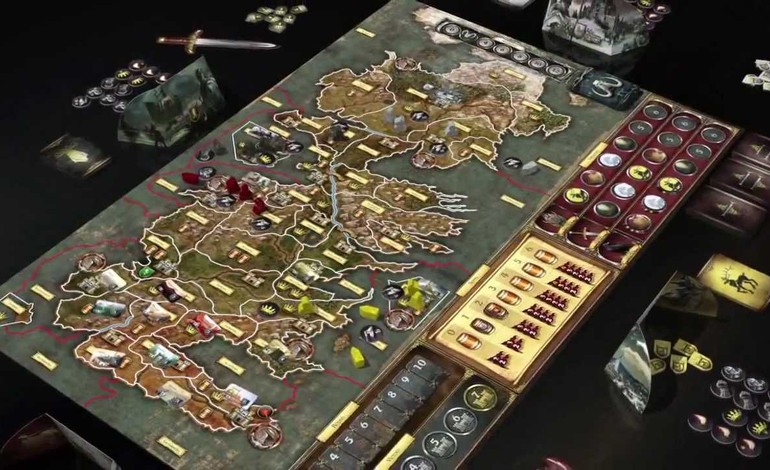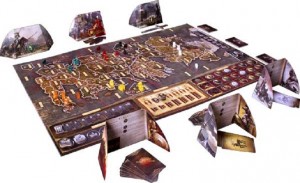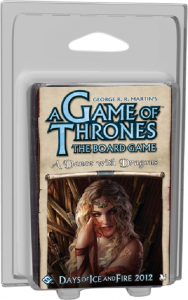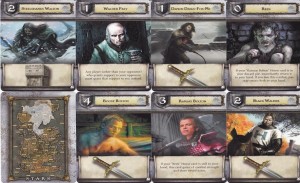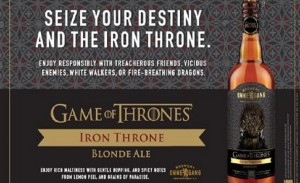Celebrating International Tabletop Day with a Game of Thrones!
For this year’s International Tabletop Day, the best way to celebrate is to play just about the nastiest game to ever come out of the Island Kingdom of … Westeros! That’s right: I’m talking about the board game version of George R.R, Martin’s epic fantasy A Game of Thrones published by Fantasy Flight Games!
This is so appropriate given the season premiere was last night, but as you play this game, you must remember several things. First of all, the theme: this is a story about absolute ruthlessness. People are tortured, betrayed, used and discarded in attempts to sit on the Iron Throne and ensure the dynastic succession of various powerful, ruling families. No-one is more ruthless than a bunch of jaded and cynical middle-aged geeks enjoying a Friday night gaming session with plenty of beer.
The beer softens the pain of the ruthlessness.
Second: people are unpredictable and selfish when trying to realize their ambitions within a short period of time, so rest assured, if you are of a strategic disposition and you fail to see a plan unfold – don’t beat yourself up. It’s not your fault that you are the only hope for Westeros.
Finally, there are no friends in Westeros. Your regular buddies who enjoy gaming with you are now completely untrustworthy. They will slit your throat with the same degree of ease as getting you a beer from the fridge.
Advice: take the beer.
Last night, my regular band of merry miscreants decided to play a variant expansion of the game known as the A Dance with Dragons expansion. Now, for those who haven’t read up to the events of the “Red Wedding”, well, this is going to be a bit of a spoiler.
Essentially, instead of representing the military strengths of the Houses of Stark, Lannister, Baratheon, Highgarden, Sunspear and Greyjoy at the start of the series, this variant establishes the houses where they approximately are located by this part of the story. For example, the Lannisters are in King’s Landing, the Starks have moved their forces South into an eventual catastrophic alliance with the Freys and Boltons and the Greyjoys have full dominance over the seas.
Though this variant accurately depicts the events of the story, the variant also represents a game imbalance. Players will discover some families’ forces are spread thin over the island, whereas others are fairly heavily concentrated in a small area, allowing them a secure power base to expand from. As a result, randomly determining who will play what family is the only fair way to begin.
The objective of the game is unchanged: to grab the most strongholds within ten turns. In the regular game, you have a couple of turns to gain resources, supply points and build up your forces a little before you start to make deals with your neighbor. Though, the combat system force you to call upon allies for their support, there is no guarantee that they will actually honor their word, establishing the fact that deals are basically meaningless in this game. It is a very cut-throat game that not only enhances someone’s inherent insecurity but also never fails to entertain a group of drunken game enthusiasts on a Friday night!
An added layer of surprise can be found in the combat cards. Using notable characters from the different families, each member has a particular combat value that can be added to the battle forces engaged with each other on the map.
Here’s a basic example: a Baratheon lnfantry unit, with a strength of 1 is defending against an attacking Stark Cavalry unit, with a strength of 2. If the Stark force plays Roose Bolton, who has a combat value of 4, the Starks can field a force with a total strength of 6. If the Baratheons play their card with a strength of 4, then their combined value is 5, which means that the Starks win. The losing force is driven into any adjacent friendly territory, or destroyed if there is no safe adjacent territory. Characters can also destroy units if they have a blade symbol on their card, countered by a castle symbol on another’s card.
The cards add to the unpredictability of the game, because unless you have spent some time reading all of the families character cards, then you don’t know what the text conditions printed on each card are. Some cards allow you to re-draw your most powerful card once you have played. Some add combat strength based on how many cards are still in your hand, and so forth. These conditions can change a battle’s outcome drastically and can fly in the face of even the most meticulous mathematician calculating potential combat strengths!
Neighbouring units can support fighting friendly forces if they have been designated a support order token. Units are assigned orders from a limited pool of tokens in the form of March, Support, Pillage, Defend or Consolidate Power. March allows military units to engage enemies. Support allows adjacent forces to add to the defensive value of nearby units (including another player’s). Pillage allows adjacent forces to remove support tokens from another player’s nearby forces orders. Defend is obvious, in that it adds defensive combat bonus to the value and Consolidate Power allows for the territory’s force to produce a power token – a basic unit of currency players can use to bid for influence.
In summary of last night, we began playing with Yours Truly as the House Stark player. As Dances with Dragons is an accelerated, unbalanced setting that means you no longer have the ability to sit on your laurels. You start fighting and making deals immediately.
To my right, House Greyjoy struck a deal with Lannister to secure its borders to the south. This meant that Greyjoy, with its entire naval force on the board had unrestricted movement throughout the western seas, from the north to the south.
To my left, the House Baratheon player launched a deep strike into the heart of Stark North. This gave me few options. I had to move south to offset any advances from both Greyjoy and Lannister. The southern forces of Highgarden and Sunspear were too preoccupied with each other and remote from the rest of us in the North to bother with. Their isolation was partially their shield but also my eventual demise.
By turn two, not only did I have Baratheon, Greyjoy and Lannister carving up parts of the North, but also we all realized that Highgarden’s starting position began with four strongholds. By the end of turn three he was up to six and within a turn or two of winning! A short game seemed to be in the cards.
However, as soon as players realized this, attention began to turn south. Unfortunately it was too late for House Stark; much like the children of Stark were scattered to the four corners of Westeros, so were the forces of Winterfell. The banners of the Dire Wolf were few and there were no supply points left for me to muster and garner forces for one more assault south.
This is a strategic limitation of the game; the shape of Westeros itself means that the Starks are always an isolated power. There are few allies for them to cultivate yet more potential enemies to defend against. Sure enough, after the north was neutralized, Greyjoy and Baratheon had freedom to move against the Lannisters or to deal with Highgarden’s sudden advantageous position.
Greyjoy assaulted the Highgarden navy and was repelled. The Lannisters assaulted the Highgarden forces and drove a salient into their forces, for a brief moment but really accomplished very little. Baratheon made an assault as well – against the Starks and picked up another castle.
In short, it was the Sunspear player who picked up the win. For as much as everyone was concentrated on Highgarden’s impetus towards victory, the other players basically overlooked Sunspear in the corner of the board! This allowed Sunspear to grow without any opposition or threat to move suddenly and quietly, picking up more strongholds than everyone else in the same manner of the vipers this realm is famous for!
The fun in this game is twofold: first, you truly discover a side to your friends that you didn’t know was there. Trust me, when they offer to get you a drink from the fridge after destroying your forces and strongholds, take it. Seriously … alcohol was used as an early anesthetic for a reason.
Secondly, it is the high unpredictability factor that can upset even the most strategic-minded player. You cannot develop a fixed and resolved battle plan for this game. There are too many factors to keep in your head. You have to be flexible and quick-witted enough to recognize and take advantage of the opportunities when they come your way.
Lie to your friends – deals are meaningless, but feel free to bludgeon your betrayers with incessant amounts of guilt. I believe I used the phrase “you are dead to me” several times before the end of the night. I also know that the Baratheon player’s beliefs were shattered when he said that he tried to get into the spirit of things by being a bastard, but just couldn’t do it.
Read your cards very carefully; understanding wording is critical before you make a move and even if you are off by one point, entire battles can collapse and you have now become the most vulnerable target in the game. Keep your big cards for when you really need them and know that your opponents are allowed to look at your discard pile to see what numbers you have played. This game illustrates Darwinian theories of natural selection very well.
In short, this is probably one of the best games to with which to celebrate International Tabletop Day. It brings out the savage worst in your friends, justifies inordinate amounts of alcohol and at the end of the session really makes you look forward to next week’s game when you can get your revenge.
In the game of thrones, you either win … or die. Happy Tabletop Day!

